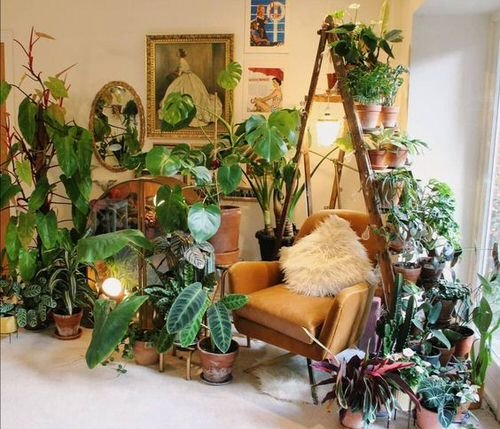Spruce Up Your Space: Cool Plant Stands To Showcase Your Indoor Plants
Hey Plant Lovers!
Hey plant lovers! Are you tired of just placing your indoor plants on a boring old shelf or table? Do you want to add some pizzazz to your space while also giving your plants the spotlight they deserve? Well, then it’s time to spruce up your space with some cool plant stands!
Not only do they add a unique touch to your décor, but they also provide a functional solution for showcasing your plants. There are so many different types of plant stands out there – from traditional styles to modern designs – that can fit any budget and aesthetic. Keep reading to discover some of the coolest plant stands to elevate your plant game!
You may be surprised to hear that the average Brit spends £306.71 a year on house plants!!!! I don't know about you but we had no idea it was that big. Check out this great article with loads more houseplant statistics that will blow your mind.
What's a plant stand and why do I need one?
Now that we've piqued your interest in plant stands, you might be wondering what exactly a plant stand is and why you need one. Simply put, a plant stand is a piece of furniture designed specifically to display indoor plants. It can come in a variety of shapes, styles, and sizes, but all plant stands have one thing in common: they elevate your plants off the ground and into the spotlight, allowing them to become a focal point of your space.
There are several reasons why you might want to invest in a plant stand:
1. Aesthetics - Plant stands can be a great stylish addition to your décor. It allows you to group your favourite plants and show them off in a way that complements your style and personality.
2. Functional Solution - A plant stand provides a practical solution for placing your plants at different heights or in various locations in your home. It can be helpful to have one if you don't have enough floor or shelf space.
3. Health Benefits - Plants have several health benefits, including purifying the air, reducing stress levels, and improving overall mood. A plant stand can help you incorporate more plants into your home, leading to a healthier environment.
Overall, a plant stand is a worthwhile investment for any plant lover. So what are you waiting for? It's time to elevate your plant game with a cool plant stand!
Different styles of plant stands for different plants
Now that you understand why plant stands are a must-have piece of furniture, it's time to explore the different styles available. Here are three of the most popular styles of plant stands and the types of plants they work best with:
1. Mid-century modern plant stands – These stands are known for their simplistic, yet stylish design. They are perfect for showcasing taller, thin plants such as snake plants, ZZ plants, and palms.
2. Bohemian plant stands – These stands are characterized by their laid-back, eclectic-style design. They are perfect for trailing plants such as ivy, pothos, and string of pearls.
3. Industrial plant stands – These stands are known for their edgy, contemporary design, typically made of metal or iron. They are perfect for styling succulents, cacti, and other small, architectural plants.
When choosing a plant stand, it's important to consider the style of your existing decor and the type of plants you plan to put on it. Opting for a plant stand that complements your style and works well with your plants will not only enhance the aesthetic appeal of your space but also help your plants thrive. And don't forget you don't always need to opt for a purpose made plant stand, using small furniture is a great platform for plants, consider small rustic side tables, industrial style stools and metal shelving.
Materials: wood, metal or a mix?
When it comes to choosing the material for your plant stand, there are a few options available. Each material has its own unique characteristics and advantages. Here are three of the most popular materials used for plant stands:
1. Wood – Wooden plant stands are timeless, classic, and versatile. They can complement any style of decor and come in a variety of finishes and styles. The natural warmth of wood also adds a sense of cosiness to a room. Wooden stands work well with all types of plants, from small succulents to tall, leafy plants. Just make sure you use water-tight planters on your stand to protect the wood from water damage.
2. Metal – Metal plant stands are trendy, sleek, and minimalist. They work well in contemporary and industrial spaces and come in a variety of finishes, such as brushed steel, blackened iron, and brass. Metal stands are perfect for showcasing small, low-maintenance plants such as cacti, succulents, and air plants.
3. A mix of materials – Combining different materials can create a unique and interesting look. For example, a wooden base with metal legs or a metal frame with wood shelves. Mixing materials can also add texture and depth to a room. This option works well for all types of plants, depending on the design of the stand.
Ultimately, the material for your plant stands should complement the existing look of your home and the style of your indoor plants. Consider the colour, texture, and leaf shape of your plants and the colour, texture, shape and finish of the stand to achieve the desired aesthetic appeal.
How to decorate with plant stands
image credit: www.balconygardenweb.com
Plant stands have become increasingly popular as more individuals have discovered the beauty of indoor gardening. Whether you have just one plant or an entire collection, displaying them on a stand can add a new dimension to your space. Here are five ways to decorate with plant stands:
1. Group similar plants together – Displaying plants with similar care requirements together not only makes it easier to care for them but also creates a cohesive look. Grouping plants of different heights, textures, and colours on a multi-tiered stand can add drama and interest to a room.
2. Use stands as accent pieces – A plant stand can serve as a decorative accent piece in a room, even if it doesn't hold a plant. A stand with clean lines and a simple design can add a modern touch. Alternatively, a vintage or antique stand can add charm and character to a space.
3. Play with colour – Consider the colour of the stand when selecting it. A bold, colourful stand can add a pop of colour to a neutral space. A neutral-coloured stand can blend in seamlessly, allowing the plants to be the focus.
4. Mix and match plant and stand styles – Pairing a modern plant with a vintage stand or vice versa can create an interesting contrast. Or, choose a stand that has a similar texture or material as the pot for a cohesive look.
5. Add greenery to unexpected spaces – Plant stands can be used in unexpected areas such as corners, narrow spaces, or even as a room divider. They can bring a touch of nature to any space, no matter how small.
Maintenance tips for your plants

Maintaining healthy indoor plants requires regular care and attention. Here are six essential maintenance tips to keep your plants thriving:
1. Watering – Make sure to water your plants regularly, but avoid overwatering as it can lead to root rot. A good rule of thumb is to water when the top inch of soil feels dry to the touch. Here is another great blog specifically about watering your house plants.
2. Lighting – Different plants have varying requirements for sunlight, so be sure to research the specific needs of your plants. Generally, plants need bright, indirect light to thrive.
3. Soil – Re-pot your plants as needed to provide fresh, nutrient-rich soil. It's also essential to use the appropriate type of soil for your plants, such as succulent or cactus soil for plants that require well-draining soil.
4. Fertilizing – Fertilize your plants regularly to provide them with essential nutrients. Use a balanced liquid fertilizer, following the instructions on the packaging for the correct dosage.
5. Pruning – Prune your plants to promote healthy growth and remove any dead or damaged leaves or stems. This will also help to prevent the spread of pests or diseases with the added benefit of keeping them looking their best.
6. Pest control – Regularly check your plants for pests and take action if necessary. Common indoor plant pests include spider mites, mealybugs, and scale insects. Use organic pest control methods, such as neem oil or insecticidal soap, to avoid harming your plants.
With a huge range and variety available online there will be something for everyone. If you are looking for more industrial and rustic style plants stands come and take a look at what we have to offer at www.vincentandbarn.co.uk.



